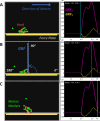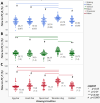Shoe configuration effects on equine forelimb gait kinetics at a walk
- PMID: 40028219
- PMCID: PMC11871903
- DOI: 10.7717/peerj.18940
Shoe configuration effects on equine forelimb gait kinetics at a walk
Abstract
The shift in vertical forces on the equine hoof surface by heart-bar, egg-bar, and wooden clog shoes can significantly impact gait kinetics. Hypotheses tested in this study were that vertical, braking, and propulsion peak force (PF) and impulse (IMP) are different while shod with heart-bar, egg-bar, open-heel, and wooden clog shoes, or while unshod, and the resultant ground reaction force vector (GRF YZ ) has the longest duration of cranial angulation with open-heel shoes followed by unshod, then egg-bar and heart-bar shoes, and the shortest with wooden clog shoes. Forelimb GRFs were recorded as six non-lame, light-breed horses walked across a force platform (four trials/side) while unshod or with egg-bar, heart-bar, open-heel, or wooden clog shoes. Outcomes included vertical, braking, and propulsive peak forces (PFV, PFB, PFP) and impulses (IMPV, IMPB, IMPP), percent stance time to each PF, braking to vertical PF ratio (PFB/PFV), walking speed (m s-1), total stance time (ST) and percent of stance in braking and propulsion. The magnitude and direction of the resultant GRFYZ vectors were quantified at 5% stance increments. Kinetic measures were compared among shoeing conditions with a mixed effects model (p-value < 0.05). A random forest classifier algorithm was used to predict shoeing condition from kinetic outcome measures. All results are reported as mean ± SEM. Trial speed, 1.51 ± 0.02 m s-1, was not different among shoeing conditions. The PFV was lower with wooden clog (6.13 ± 0.1 N kg-1) versus egg-bar (6.35 ± 0.1 N kg-1) shoes or unshod (6.32 ± 0.1 N kg-1); the PFP was higher with wooden clog (0.81 ± 0.03 N kg-1) versus open-heel (0.71 ± 0.03 N kg-1) or egg-bar (0.75 ± 0.03 N kg-1) shoes or unshod (0.74 ± 0.03 N kg-1), and lower with open-heel compared to heart-bar shoes (0.77 ± 0.03 N kg-1). Both IMP B and IMPV were higher with open-heel shoes (-0.19 ± 0.008 N s kg-1, 3.28 ± 0.09 N s kg-1) versus unshod (-0.17 ± 0.008 N s kg-1, 3.16 ± 0.09 N s kg-1), and IMPV was higher with wooden clog shoes (3.26 ± 0.09 N s kg-1) versus unshod. With wooden clog shoes, PFB/PFV (0.12 ± 0.004) was higher than unshod (0.11 ± 0.004). Percent time to peak PFV, PFB, and PFP, and percent braking time were highest and percent propulsion time lowest with wooden clog shoes. The magnitude of the GRFYZ vector with the wooden clog shoe was the highest among shoeing conditions during the first stance half, lowest during the second stance half, highest during late propulsion, and had the most gradual braking to propulsion transition. Vectors were angled cranially with wooden clog shoes slightly longer than the others. Wooden clog shoes was the only shoeing condition accurately predicted from kinetic measures. Distinct, predictable changes in gait kinetics with wooden clog shoes may reduce stresses on hoof structures. Study results enhance knowledge about shoe effects on equine gait kinetics and cutting-edge measures to quantify them.
Keywords: Animal biomechanics; Bar shoes; Braking; Force platform; Forelimb; Ground reaction force; Hoof; Horse; Propulsion; Wooden clog.
©2025 Aoun et al.
Conflict of interest statement
The authors declare there are no competing interests.
Figures










Similar articles
-
Effects of different shoeing conditions on equine cervical and back kinematics during walking and trotting on a soft surface.J Equine Vet Sci. 2024 Nov;142:105194. doi: 10.1016/j.jevs.2024.105194. Epub 2024 Sep 12. J Equine Vet Sci. 2024. PMID: 39276952
-
Effect of hoof boots and toe-extension shoes on the forelimb kinetics of horses during walking.Am J Vet Res. 2016 May;77(5):527-33. doi: 10.2460/ajvr.77.5.527. Am J Vet Res. 2016. PMID: 27111020
-
Shoe configuration effects on third phalanx and capsule motion of unaffected and laminitic equine hooves in-situ.PLoS One. 2023 May 8;18(5):e0285475. doi: 10.1371/journal.pone.0285475. eCollection 2023. PLoS One. 2023. PMID: 37155654 Free PMC article.
-
Horseshoe effects on equine gait-A systematic scoping review.Vet Surg. 2025 Jan;54(1):31-51. doi: 10.1111/vsu.14162. Epub 2024 Sep 15. Vet Surg. 2025. PMID: 39278729 Free PMC article.
-
The role and importance of farriery in equine veterinary practice.Vet Clin North Am Equine Pract. 2003 Aug;19(2):273-83. doi: 10.1016/s0749-0739(03)00022-1. Vet Clin North Am Equine Pract. 2003. PMID: 14575160 Review.
References
-
- Aflatoony L. Flex, breathe, fit, and walk: exploring technologies accessible in academia for design and production of a custom fit shoes. International textile and apparel association annual conference proceedings.2019.
-
- Back W, Pille F. The role of the hoof and shoeing. In: Back W, Clayton H, editors. Equine locomotion. Elsevier; Cambridge: 2013. pp. 147–174.
MeSH terms
LinkOut - more resources
Full Text Sources
Miscellaneous

